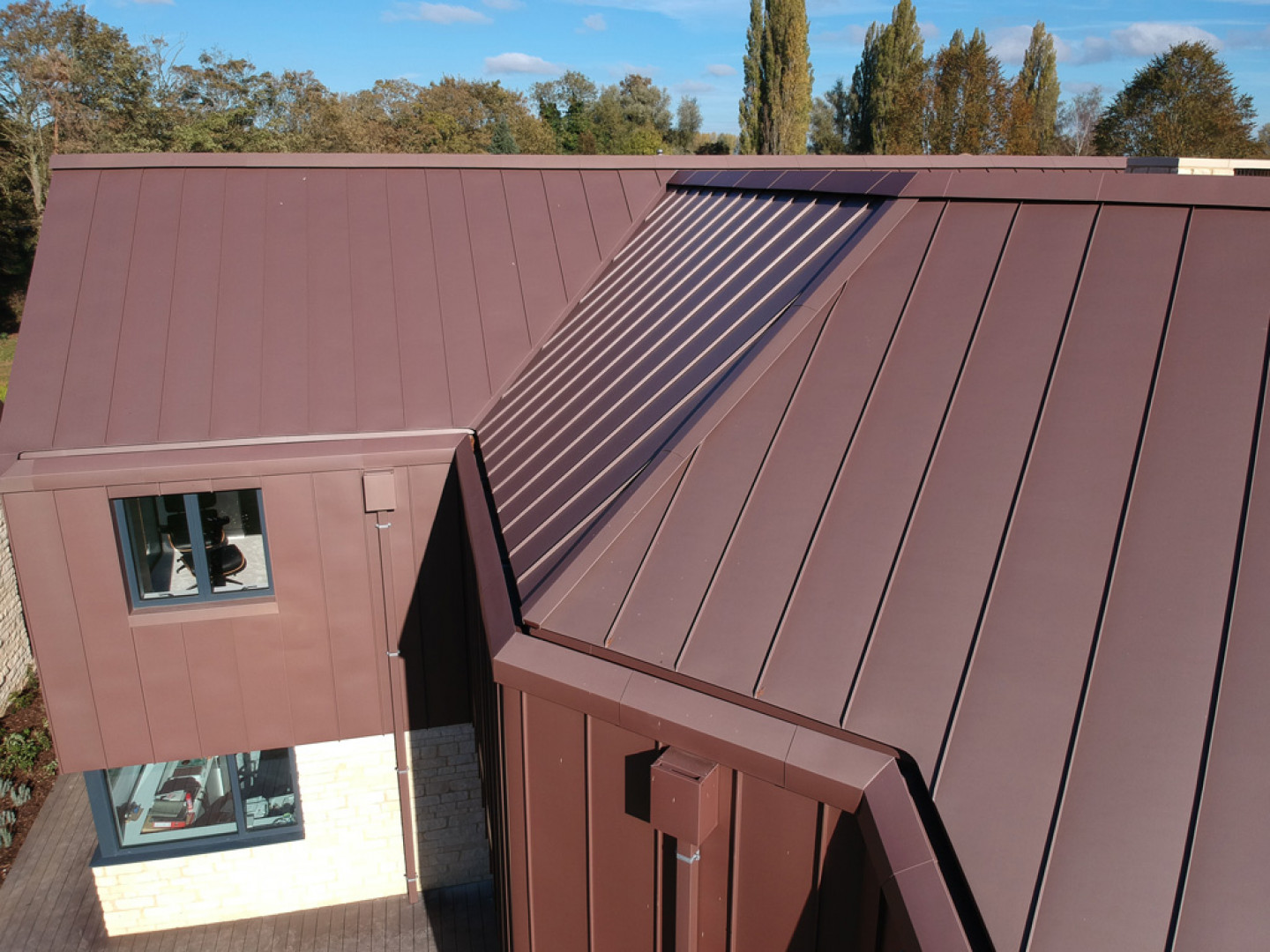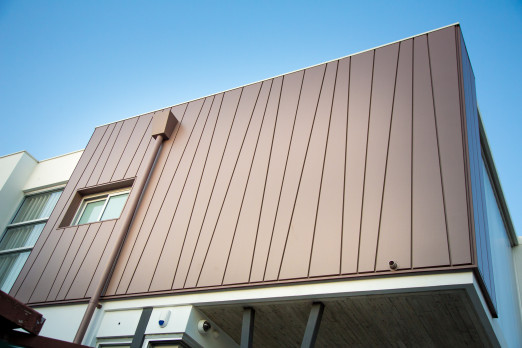Zinc is an excellent roofing and cladding material which will give long and almost maintenance-free service if installed properly. Proper installation means not only the correct fixing of the zinc itself, but also the correct design and installation of the supporting structure.
This article, prepared with our partners at elZinc®, looks at some options for the supporting structure for zinc roofing, which traditionally provides a continuous support for the roofing material.
What is a zinc roof build up?
The supporting structure for a zinc roof is made up in a series of different layers on site, known as the ‘build up’. Depending on the design of the roof, it can include, from outside to inside:
• Zinc;
• Underlay;
• Substrate (providing direct support for the Zinc);
• Air layer (ventilated/cold roofs only);
• Insulation;
• Vapour control layer (VCL) or vapour barrier, and
• The Principal load bearing structure.
Modern methods of construction can combine some of these elements, such as the substrate, insulation and VCL.
A word about underlays
Underlays sit between the zinc and its supporting substrate and can act as a separating layer, slip layer or protection for the substrate during construction.
Structural underlays consist of an air-permeable, fibrous mat, lifting the zinc slightly (~8mm) off the substrate surface.
Combined with a breather membrane, a structural underlay:
• Can act as a means of draining condensate from the underside of the zinc,
• Can even out any slight unevenness in the substrate, and
• is often recommended by elZinc® as they have proven beneficial to the longevity of zinc roofs.
Structural underlays are recommended in particular on warm roofs.
Cold roof or warm roof? Ventilated or unventilated?
The two designs most commonly used with elZinc® are ventilated roof and unventilated roof, also known respectively as “cold roof” and “warm roof”.
Choosing which design is the most appropriate for a particular project depends on many factors such as roof form, available height, cost, and aesthetics. This is best discussed on a project by project basis with our technical team.
However, here is a rule of thumb guide to get you started.
Ventilated zinc roofs
Ventilated (cold) zinc roofs work best with:
• A decent pitch,
• Simple geometry,
• Adequately dimensioned air gap.
They are not so appropriate for:
• Low pitched roofs (unless good cross ventilation can be provided, which limits the rafter length),
• Roofs where the required height of the air layer is problematic,
• Geometrically complicated roofs (where it is difficult to achieve enough air movement through the layer),
• Where ridge details are required to be as discreet as possible,
• Other factors mean the cost would be prohibitive.
Unventilated zinc roofs
Unventilated (Warm) zinc roofs are often used when:
• The pitch of the roof needs to be low
• The roof has complex geometry
• A slimmer roof construction is required.
However, a warm roof construction is more sensitive to the construction process itself. For example, warm zinc roofs should be avoided for installations over humid substrates which trap moisture. Warm zinc roofs can be particularly susceptible to improper installation of the vapour barrier which allows moisture migrating through the roof to condense (in cold weather) on the rear face of the zinc. As a result, good design, installation and site practices are essential.
Warm zinc roof construction can use timber substrates, but the need to reduce cold bridging in many countries has led to the use of rigid and composite insulation boards or sandwich panels as the direct substrate under the zinc.
Example zinc roof build ups
The following examples are just some of the many possibilities that exist. For advice on which build up would be most appropriate for your project, get in touch.
Ventilated zinc roof build up (cold roofs)
These designs introduce an air layer under the substrate which draws warmed, moist air out from under the zinc. This layer also helps to dissipate heat in the summer months, keeping the building cooler.
Air inlets and outlets are created at the eaves and ridge of the roof, using perforated elZinc® material as an insect mesh. The net area required depends on roof pitch and is given opposite.
If a structural underlay is required, any draining membrane installed below it should be a breather membrane, since any condensate will evaporate down through it and the substrate into the air layer, where it is drawn out from the roof via the outlet.
Unventilated zinc roof build up (warm roof)
These designs incorporate a high performance, and when required, self-sealing vapour barrier on the warm side of the insulation.
The effectiveness of this vapour barrier is of paramount importance to the roof, so:
• Its installation should be carefully controlled on site
• All joints and penetrations should be sealed
• It should wrap around all edges of the insulation
• It should always be installed over a structural deck
Composite insulating boards provide a timber decking that is factory-bonded to the insulation, so the installation of the zinc is executed using traditional clips and fixings.
Warm zinc roof on rigid insulation
Rigid insulation is used in combination with special clips that enable the zinc to be fixed to the supporting decking below. The insulation should be stable up to 100°C, must be able to withstand foot traffic and not deform during the lifetime of the building. Plywood or similar can be used. Only one screw is used per clip, so pull-out values and clip centres should be checked, and deck thickness adjusted.
Warm zinc roof on cellular glass insulation
Cellular glass is mainly used in high humidity applications such as swimming pools, the cellular glass panels are 100% vapour tight which stops any vapour drive from the building.
Unventilated zinc roof on timber insulation board
The factory bonded insulating board is screw fixed through the vapour barrier into the decking below. The high performance vapour barrier must self- seal against these fixings, and all laps and roof penetrations must be taped and sealed. The exterior face of the insulating board should be exterior grade plywood or class 3 OSB, at least 18mm thick. The performance of the vapour barrier is fundamental in this design. Typical Sd values should be ≥ 800m and the vapour barrier must be suitable for laying over a trapezoidal deck.
Carrier panel warm roof
This approach is very popular with more complex buildings, but as is the case with all warm zinc roofs, it is vitally important that all panel joints are vapour-tight, the same is true for all perimeters of the panel installation.
Carrier panels have a thicker outside skin (≥0,7mm) to ensure pull- out values for the clips are maintained at 560N per clip or more. Installation should be according to the manufacturer’s instructions.
The standing seam clips should be fixed using fasteners able to achieve a pull-out value of 560N or greater per clip. The fixings of the carrier panel to the steel structure are normally visible from the inside.

